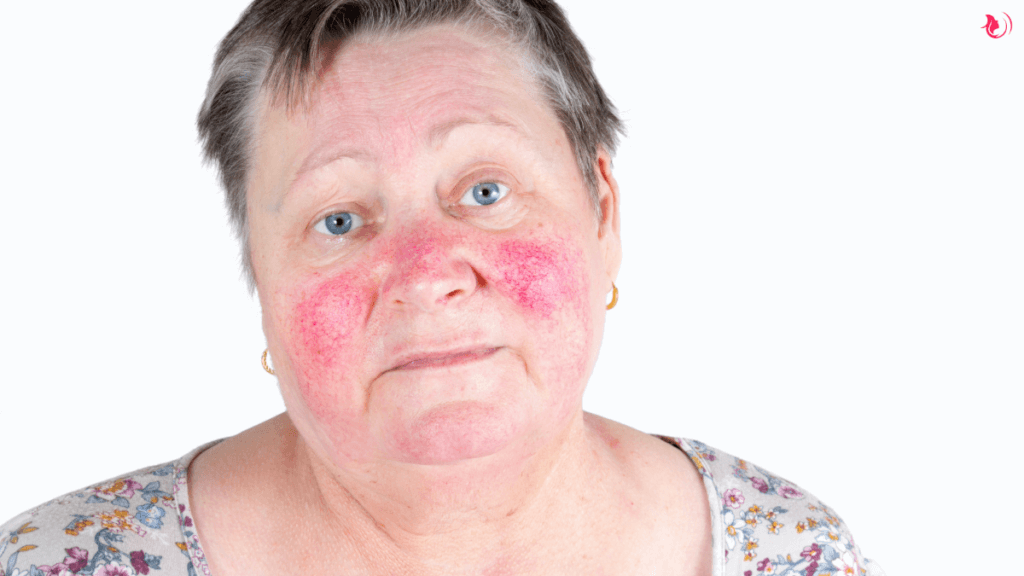Rosacea is a chronic recurrent inflammatory disease primarily affecting the facial skin, commonly seen in women aged 30–55. This condition is characterized by persistent redness, visible blood vessels, and sometimes small, red, pus-filled bumps.
The prevalence of rosacea varies globally, ranging from 0.1% to 22%, with a reported prevalence of 3.48% in China. The pathogenesis of rosacea is complex and involves multiple factors including genetics, microbial dysbiosis, neurovascular dysfunction, and immune system disorders.
Key Characteristics and Symptoms
- Facial Redness: Persistent erythema or redness in the central part of the face, especially the cheeks, nose, chin, and forehead, is a hallmark of rosacea.
- Visible Blood Vessels: Small, dilated blood vessels on the nose and cheeks often swell and become visible, adding to the redness.
- Bumps and Pimples: Many individuals with rosacea develop acne-like pimples that are small, red, and pus-filled.
- Eye Problems: Known as ocular rosacea, this subtype causes redness, dryness, and irritation in the eyes and eyelids.
- Thickened Skin: In some cases, particularly in men, rosacea can cause the skin to thicken and enlarge, usually on the nose, a condition known as rhinophyma.
Causes and Triggers

Recent studies have significantly advanced our understanding of rosacea. While the exact cause of rosacea remains unknown, several factors are believed to contribute to its development. Genetic factors play a significant role, as a family history of rosacea or a tendency to blush easily can increase the risk of developing the condition. Environmental factors also contribute, with exposure to sunlight, wind, or extreme temperatures known to trigger or exacerbate rosacea symptoms.
Lifestyle choices have been linked to the severity of rosacea flare-ups. Certain foods and beverages, particularly spicy foods, alcohol, and hot drinks, have been identified as common triggers. Studies are exploring how dietary modifications can help manage symptoms, and there is growing interest in the role of gut health and its connection to skin conditions like rosacea.
Microorganisms, including the Demodex mite and the bacteria Helicobacter pylori, are another area of intense research. While the exact relationship between these microorganisms and rosacea is still being studied, some findings suggest that they may play a role in triggering the inflammatory response associated with the condition. This has led to the exploration of treatments targeting these microorganisms to reduce symptoms.
Diagnosis and Treatment
Diagnosing rosacea typically involves a thorough examination of the skin and a review of the patient’s medical history. No specific tests exist for rosacea, but doctors may rule out other conditions that cause similar symptoms.
- Topical Medications: Treatments like metronidazole, azelaic acid, and ivermectin can reduce redness and inflammation.
- Oral Antibiotics: Medications such as doxycycline are used for more severe cases.
- Laser and Light Therapies: These treatments help reduce visible blood vessels and redness by targeting the affected areas with specific wavelengths of light.
- Lifestyle Modifications: Avoiding known triggers, using sunscreen, and practicing gentle skincare are essential for managing rosacea symptoms effectively.
Living with Rosacea
Managing rosacea involves understanding and avoiding triggers, using prescribed treatments consistently, and protecting the skin from environmental factors. Effective management starts with using gentle skincare products. Avoid harsh cleansers and abrasive materials that can irritate the skin, opting instead for products designed specifically for sensitive skin. Another key aspect is daily sunscreen application, as protecting the skin from UV rays is crucial since sun exposure can exacerbate rosacea symptoms.
Monitoring and managing triggers plays a vital role in living with rosacea. Keeping a diary to identify and avoid foods, activities, or conditions that cause flare-ups can help manage the condition more effectively. By recognising these triggers, individuals can take proactive steps to minimise their impact and maintain better control over their symptoms.
The Impact of Rosacea on Quality of Life and Mental Health

Rosacea’s visible symptoms can significantly impact a person’s quality of life (QOL) and mental health. Studies have shown that rosacea is associated with several systemic diseases and psychosocial comorbidities such as anxiety and depression. The persistent erythema, telangiectasia, papules, pustules, and even rhinophyma can cause discomfort, including burning, stinging, and tingling sensations. These symptoms can lead to a significant psychological burden, affecting social interactions, occupational outcomes, and overall mental health.
The World Health Organization (WHO) defines quality of life (QOL) as an index of people’s ability to lead a productive and enjoyable life. In dermatology, the impact of skin diseases on patients’ QOL is a critical concern. Psoriasis, atopic dermatitis, and acne-related scars are known to negatively impact QOL. For rosacea, tools like the Dermatology Life Quality Index (DLQI) and Rosacea-specific Quality of Life (RosQol) assessments are used to measure the burden of the disease on patients.
Studies have shown that rosacea patients often experience a significant psychological burden, with increased risks of anxiety and depression. Factors such as social anxiety, low self-esteem, and embarrassment due to the visible nature of the condition can lead to avoidance behaviors and social withdrawal. The severity of rosacea has been found to correlate with the level of impaired QOL and the incidence of anxiety and depression. The more severe the symptoms, the greater the impact on mental health.
Recent research suggests that the gut-brain-skin axis may play a role in the comorbidity of rosacea with psychiatric disorders. Microecological dysbiosis and psychological stressors can impair the gastrointestinal tract’s integrity, leading to systemic inflammation. Inflammatory pathways involving cytokines such as interleukin (IL)-1, IL-12, and MMP are shared between rosacea, depression, and anxiety, explaining the observed comorbidity.
A Global Condition
Rosacea is a chronic skin condition that affects millions worldwide, significantly impacting patients’ quality of life and mental health. Understanding its symptoms, triggers, and treatments is crucial for managing the condition effectively. Recognizing the psychological burden of rosacea and providing comprehensive care that addresses both physical and mental health aspects is essential.
By raising awareness of rosacea-related QOL impacts and encouraging patients to seek psychological help when needed, healthcare providers can improve outcomes and support better overall health for those living with this condition.


